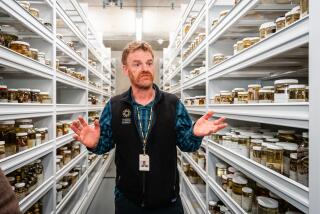Lizard Is Source of Newest Diabetes Drug
- Share via
The venomous bite of a homely Southwestern lizard may be dangerous, but it also holds the key to a drug that may make life easier for diabetics.
The Food and Drug Administration on Friday approved a drug to treat type 2, or adult- onset, diabetes that is a synthetic version of a substance found in the saliva of a Gila monster, a stout reptile that takes its name from Arizona’s Gila River.
The approval of the drug Byetta was the second FDA endorsement in six weeks for Amylin Pharmaceuticals Inc., strengthening the small San Diego company’s position in diabetes treatments. The agency had cleared Amylin’s first drug, Symlin, also for diabetes, last month.
The back-to-back approvals were a vindication for Amylin, which investors had given up on in the late 1990s.
“No company of any size has accomplished this in any year and certainly not in two months,” said Ginger Graham, Amylin’s chief executive. “Sometimes I think we stand here as a miracle.”
The substance that is the basis for Byetta was discovered in the early 1990s by John Eng, an endocrinologist with the Veterans Administration, and was licensed to Amylin.
A string of amino acids, the substance mimics the action of a human hormone that is known to stimulate insulin secretion, slowing digestion and controlling blood-sugar levels.
The FDA approved Byetta for diabetics on oral medications rather than insulin to control their disease. Amylin said 6 million diabetics fall into that category, and nearly two-thirds of them have trouble controlling blood sugar with oral drugs metformin and sulfonylurea.
Byetta is taken by injection twice daily, an hour before breakfast and dinner. One drawback is that, unlike insulin, it must be refrigerated. Byetta can cause nausea, but Amylin said that in general it doesn’t last beyond two weeks.
Sales estimates on Wall Street range from $51 million to $150 million this year, with peak sales of $700 million to $1.6 billion. Amylin hasn’t made any projections.
“I am very confident this can be a big drug,” said Lehman Bros. analyst Jim Birchenough.
Amylin will market the drug and share profit with Eli Lilly & Co., which in 2002 agreed to pay $325 million to co-develop the diabetes shot.
Eng made the discovery that led to the drug by accident. While testing a sample of Gila monster saliva for the presence of a known hormone, he came across a new substance, which he named exendin-4.
After studying exendin-4, Eng realized it would be useful as a diabetes drug. He tried to persuade the Veterans Administration to patent his discovery, but the agency declined. So Eng, who was making $40,000 a year at the time, spent $8,000 to obtain a patent himself.
Eng presented his research at a medical meeting in 1996, drawing interest from Amylin and Lilly, the leading producer of insulin, but only Amylin proposed a deal. Eng said he would receive a low-single-digit percentage royalty on Byetta sales.
A father of four, Eng said he considered the drug his “fifth child.”
“This is a happy occasion,” he said. “But I never stop worrying that the child will do well and help diabetic people as hoped.”
Amylin said its sales force of 350 to 400 people would promote Byetta to 60,000 doctors who write 70% of prescriptions for diabetes drugs. Lilly also will market the product.
The annual wholesale cost of the drug will be $1,764 or $2,070, depending on the dose, Amylin said. Byetta is not covered by insurance, but company executives believe that it will be.
Amylin’s shares closed Friday at $17, off $1.18, on Nasdaq. Yaron Werber, an analyst with Smith Barney, said investors were skittish about new biotech drugs in the wake of such disappointments as Biogen Idec Inc.’s Tysabri, which was pulled from the market in February after multiple sclerosis patients developed deadly infections.
Lilly shares rose 47 cents to $58.47 on the New York Stock Exchange.
More to Read
Inside the business of entertainment
The Wide Shot brings you news, analysis and insights on everything from streaming wars to production — and what it all means for the future.
You may occasionally receive promotional content from the Los Angeles Times.








